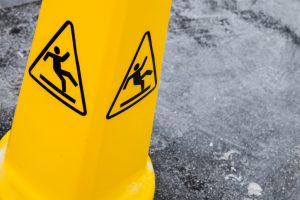Slip and fall cases are some of the most complex personal injury cases to litigate due a variety of compounding factors. For one, the plaintiff must be able to attribute their fall to the place of business’ negligence. This is particularly difficult to prove, considering that in order to assert the business owner’s negligence, there must be proof that they had previous knowledge of faulty conditions and did not make adjustments accordingly.

Slip and fall cases are often difficult to litigate due to burden of proving negligence.
Foremost, it is important to acknowledge that slip and fall cases are typically considered negligence cases and thereby must follow the same legal patterns as negligence cases. As with other tort and negligence cases, assessing the legal liability of the accused party can be accomplished by evaluating three critical elements of a slip and fall case. These elements are duty, breach of duty and causation.
Duty is the term used to acknowledge one party’s legal or contractual obligation to another party. In the case of a slip-and-fall case, the business owner owes a legal duty of care to provide a safe environment.
The breach of duty occurs when one party breaches their duty of care to the other party. In this example, the store owner would have breached their duty of care to the decedent by providing an unsafe environment with minimal warning to the patron. This could manifest itself in many ways, such as the presence of slippery fluid on the floor without appropriate warning or signage.
The third element required in a wrongful death case is causation. Essentially, the court must be able to reasonably infer that the accused party’s breach of duty directly caused the death of the other party. The court must also be able to prove that the owner is truly negligent – that is, that they were aware of unsafe conditions and didn’t act to amend them. For example, in the case of a slip-and-fall, it must be reasonably assumed that the business owner was notified of a slippery substance on the floor, and decided not to fix it anyway.
Following this example, it is clear that the burden of proof is often tied to the plaintiff. This became increasingly frustrating for claimants seeking legal reparations for their injuries. However, there is a landmark New Jersey supreme court case titled Wollerman v. Grand Union Stores, Inc(1966) which modified this. The Wollerman ruleprovides an understanding that some businesses naturally interact with their patrons in a more risk-prone way. For example, a grocery store with open fruit and vegetable bins can inherently lead to more produce on the floor and more possible slips. As such, It is the responsibility of the business to make sure that their customer safety protocol is in line with the risk level of their operations. Following this method, the burden of proof shifts from the plaintiff to the defendant.
At Aretsky Law Group P.C., we understand how difficult it can be for your family to deal with a slip-and-fall, and we hope to provide legal guidance during this upsetting and often frustrating time. We understand that there are nuanced complexities following each personal injury case, and are here to help you navigate the legalities of these varying situations.
 New Jersey Lawyer Blog
New Jersey Lawyer Blog

